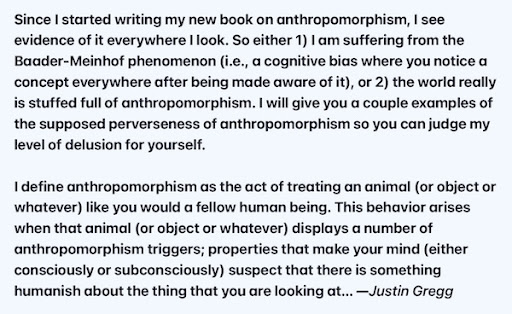"Kamala Harris and Donald Trump promise radically different paths for the country. Although neither has said much about science, the winner of next month’s US presidential election will have a substantial impact on the nation’s research enterprise by influencing funding levels, the ability of foreign scientists to work in the country, rules on overseas collaborations, and the training of the next generation of scientists. See pages 249 and 262."
IntroductionLots to consider in these pages. Much to learn. Just getting started. UPDATE: Likin' it. Seein' some cross-reference potential with this one.
The Primal Scene of Academic Writing
All academic writers begin their journeys in the classroom. There they write for an audience of one person: the teacher.
Professors read students’ work as evaluators. The evaluator has a specific job: to read their students’ writing from beginning to end and assess it. (The job usually includes writing a response, too, but let’s put that task aside.)
The central quality of the evaluator’s job is thoroughness. She will read your work closely and completely. One of my former teachers, Edward Tayler, described it this way:With proper allowance for human weakness, you may reasonably hope for an attentive, sympathetic reading of every word you write—a kind of reading you may not reasonably hope for ever again.This kind of careful reading is a gift. As Simone Weil put it: “Attention is the rarest and purest form of generosity.”
But there’s another concrete and essential reason why student writers may expect this careful attention: the reader is getting paid.
The evaluator’s position as a paid reader is the exact opposite of the general reader’s. General readers pay for the privilege of reading (by buying books or magazines, or subscribing to websites), and they feel no obligation whatever to be thorough. General readers will quit reading if they don’t enjoy what they’re doing, or if they don’t feel they’re getting something worthwhile out of the experience.
Every academic writer begins by writing for a captive audience: someone who is literally being paid to pay attention. Long before they set foot in graduate school or venture beyond it, academic writers spend years getting used to a reader who can’t be distracted or discouraged, because that reader receives cash to read to the end.
The main problem with writing for a captive audience is that it teaches us to take the reader’s attention for granted. Student writers learn to be long-winded because they know—consciously or not—that their reader won’t quit on them. They can begin a mile away from their topic and slowly work their way in. Or they may supply three examples where one will do (usually to fill up pages to reach an assigned word limit—tell me you’ve never done that), all because they trust that the reader will dutifully trudge through.
When student writers sit down to write for a paid audience of one, they enact the primal scene of academic writing. Like other mythical moments of originary consciousness—the fall of Adam and Eve, the Freudian discovery of civilization’s discontents, and so on—this primal scene portends disappointment. It points to its own future failures.
But academic writing’s primal scene begets far worse than prolixity. Its worst symptom is that it promotes a disconnection from, and disregard for, the reader.
If you know that your readers will stay with you no matter what, you don’t have to worry too much about how you treat them. Instead of working to care for the reader, academic writers are taught by their earliest experience that readers are unconditionally invested. They require no consideration because they’re already on the hook. That unfortunate lesson invites all kinds of bad writing, and with it the genesis of this book.
Like all primal scenes, the academic writer’s beginning ripples forward to affect the future. Academic writers don’t leave our primal scene behind. Instead, we re-create and repeat it. (I know I have. I’ve made many of the mistakes that I warn against in this book.) After we pass the stage of writing for an audience of one, we go on to make many of the same bad moves when we write for wider audiences, often with the hope of getting published. Unexamined bad habits become enshrined. Care for the reader remains an afterthought—or no thought at all.
The primal scene thus stays with us ever after. Writing a paper for your undergraduate professor, a dissertation for a committee, and an article for publication are really three versions of the same exercise, separated by time and experience. Like the professor who reads a student’s work, the evaluators of journal and book submissions are paid readers also…
Cassuto, Leonard. Academic Writing as if Readers Matter (Skills for Scholars) (pp. 14-16). Princeton University Press. Kindle on.
Despite all the uncertainties about academic judgment, I aim to combat intellectual cynicism. Post-structuralism has led large numbers of academics to view notions of truth and reality as highly arbitrary. Yet many still care deeply about “excellence” and remain strongly committed to identifying and rewarding it, though they may not define it the same way.Much attention going to the sociocultural / organizational politics of postsecondary academia thus far. Which, of course, cannot but factor into the way one "thinks."
I also aim to provide a deeper understanding, grounded in solid research, of the competing criteria of evaluation at stake in academic debates. Empirically grounded disciplines, such as political science and sociology, have experienced important conflicts regarding the place of formal theory and quantitative research techniques in disciplnary standards of excellence. In political science, strong tensions have accompanied the growing influence of rational choice theory... [Loc 205]


















































